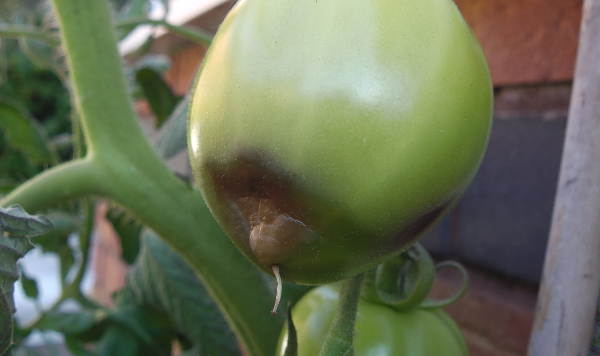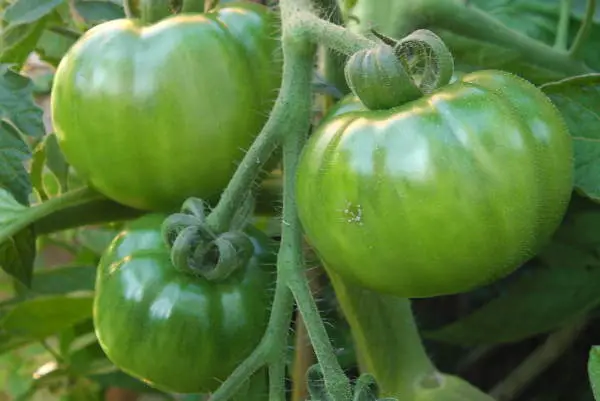First Blossom End Rot (BER) of the season …
- Variety: Crimson Crush
- Growing in: Large pot
- Watering method: Stood in tray and watered twice each day
It’s interesting to note that because of the hot weather we’re having in the UK at the moment, even large pots or containers watered twice a day in trays, can end up with dry soil. Just a few hours of dry soil can cause BER in medium and large varieties.

The plant below is from the same seed packet.

A hybrid F1 variety like Crimson Crush, is a first generation cross between two parent varieties. If two flowers (one Mum one Dad) were not crossed correctly, you can end up with seeds that produce wonky toms! Either that, or Crimson Crush isn’t an F1 but perhaps an F3, 4 or 5, where the unstable hybrid (F2 onwards), has not been bred out. Tomatoes produced from hybrids (F2 onwards) usually become stable at the fifth or sixth generation – F5, F6.
Back to BER
However, tomatoes growing in Oasesbox and Quadgrow planters have no sign of any BER on medium and large varieties. Cherry varieties aren’t susceptible to BER as the larger varieties are.
If you experience Blossom End Rot this season, I highly recommend the Oasesbox or Quadgrow planter for growing tomatoes, chillies, peppers or aubergines next season!
Below is a good way to prune tomato plants for the best taste and growth.
Leaf Pruning – please read carefully before chopping!
It’s a good idea to remove leaf branches up to the first truss – when the first truss has started to set fruit. However, it is important to understand that the closest leaf branch to each truss of fruit, provides the tomatoes on that truss with most of the energy they need for growth.
In other words, the leaves closest to each truss of fruit provide most of the energy for the growth and sugars (taste) on that particular truss.
This is important to keep in mind when we are removing leaf branches.
Remove the middle branch when plants are too vegetative (leafy)
For example, if there are three leaf branches between the first and second trusses, the best way to prune is to remove the middle leaf branch, leaving the branches nearest the trusses.
This is done as the fruit are swelling to encourage fruit growth, but once they have begun to ripen, all the leaf branches up to a given truss (the ripe truss) can be removed.
We want energy to go into fruit production – not making a lot of leaves!
Removing all of the leaf branches up to the second truss can be done when the fruit on the second truss is ripening (not just setting). In other words, leaf branches can be removed up to the truss that is producing ripe fruit.
By this time, the ripening fruit will have received plenty of sugar from the nearest leaf branches.
Pruning is also important, especially for plants growing in greenhouses, because it helps air flow around the base of plants and helps keep them healthy.
Four or five trusses outside
If you are growing outside to four or five trusses, I wouldn’t worry too much about removing all branches up to the ripening truss – just remove leaf branches up to the first or second truss. Also, middle leaf branches as fruit are swelling and trim long leaf branches if necessary.
Pruning helps keep a balance of leaves/fruit and plants producing enough energy/sugars from the leaves to supply to the fruit.
Tomato plants have two phases of growth
- The vegetative phase – producing the stems and leaves etc.
- The generative/reproductive phase – producing the flowers and fruit etc.
The plant begins its life in the vegetative phase and when flowering and fruiting begins, it moves into its reproductive phase.
However, these phases are not mutually exclusive – in the second phase of flowering and fruiting, we still want plants to be growing stems and leaves to support higher trusses, but the main objective is to provide enough energy for the continued growth of the plant and tomatoes over a given period of time. This means that a balance of vegetative and reproductive growth is required.
This is where pruning comes in … also known as plant steering.
We want to direct energy from the leaves to the fruit. We don’t want to create a lot of big luxurious fat juicy leaves so that when they get a bit older, will become a drain on the plant’s resources and reduce the amount of tomatoes we get! By the way, tomato leaves are poisonous – don’t eat them!
Leaves in shade are less important
For example, if you are growing plants up against a wall or fence, the leaves at the back will be producing much less energy for the plant than those at the front in direct sunlight, so shaded leaves can be removed (as long as there are enough leaves at the front of course!).
If you’ve ever tried to grow large tomato varieties that run out of steam at the second or third truss, it’s probably because the vegetative and reproductive balance needs adjusting. These adjustments can also be made by the amount and the balance of nutrients we give our plants. Nitrogen encourages leaf growth and potassium flower and fruit growth. However, nitrogen is still needed to grow the upper trusses, so we need to get the balance right, over the length of time we are growing our tomato plants.
Those with a longer growing season can grow more trusses and larger varieties that need more time and sun to produce their full flavour.
If we knew in advance what sort of summer is coming, we could always grow the varieties that would do best in those conditions.
Regards,
Nick

Mark
Great advice thanks Nick. I’ve removed the leaves as advised as my plants have grown enormous in the greenhouse and got very bushy/leafy. I discovered a few toms with BER today, notably the ones in grow bags with grow bag pot inserts. The same variety ( gardeners delight) in fabric pots seem fine, even though they dry out quicker! Best wishes, Mark
Nick
Hi Mark, good to know the pruning advice is helpful … sometimes BER strikes without good reason – it is difficult to control when the weather is so hot!
Rob
Hi Nick,
Thank you for another informative newsletter. I have just savoured my first Maskotka, Sungold, Cherry Falls and Sun Cherry!
I grow mainly greenhouse cherry tomatoes and notice that with some strains (especially Sweet Million) the plants produce trusses with significantly more flowers than the plant is able to sustain. Later in the season, I will normally have to remove up to 100 tiny flowers or undeveloped fruit from the higher trusses. Since all of my other cherry varieties look healthy, I’m guessing the over-production of flowers is a peculiarity of Sweet Million. But I’d like to ask if you can you think of any other explanation for this. Thank you.
Kind regards,
Rob
Nick
Hi Rob, an abundance of flowers is usually caused by high light levels as flower buds are forming.
Being exposed to cold temperatures (around 5C) when young plants have developed their second true leaves – the cold treatment can also help produce good flowering. It may also be caused by a boost of potassium before flowering – any of these or a combination may cause more flowers than usual to form on the trusses.
I’ve had the opposite problem with some of my plants, where trusses have fewer flowers than expected. I put this down to black pots in direct sunlight – roots have become too hot and plants have become heat stressed – each season has its own challenges!
Kind regards,
Nick
Rhys Jaggar
First orange Maskotkas of the season noticed yesterday.
Mercifully no BER here yet: I have kept my Alicantes and Tigerellas in the shade during the heat and they seem OK.
Good advice about deleafing, I probably need it in around 3 weeks! No doubt those growing indoors are further ahead….
Nick
Hi Rhys, my Lizzano toms are just turning orange too – will have to wait a bit longer for the larger varieties.
Pauline Helman
Hi Nick,
I am so grateful for your well explained advice on this topic, it is something I have previously not been clear about. Is there any time of day that you would consider advisable to carry out this removal of leaves, for rapid and safe healing of the cut and to help prevent disease entering the plant?
Many thanks, Nick, for such a useful and enjoyable newsletter.
Very best wishes,
Pauline.
Nick
Hi Pauline,
I usually remove the leaf branches by hand with a sharp pull upwards – using a blade can transfer disease – the wounds heal themselves.
The lower leaf branches can be removed as soon as the first truss has started to set fruit – when pea-like toms appear.
if, for example, you have three leaf branches between truss one and two, wait for the second truss to start to set before before removing the middle branch. It isn’t critical as long as leaf branches are removed gradually.
As soon as a truss has fully ripened then all leaf branches below that truss can be removed.
Hope that’s clear…
Kind regards,
Nick
Pauline
Hi Nick,
Many thanks for that information, so helpful and clear, and exactly what I wanted to know about leaf branch removal. I was astonished how cleanly the leaf branch comes away with that upward pulling action!
My smaller tomato varieties are ripening nicely, Sungold is lovely and sweet, and the grafted Crimson Crush is cropping heavily.
Kind regards,
Pauline.
Anonymous
Thanks Nick
Had been slightly confused as to when to remove leaf branches.
Regards,
Frank,
Nick
Hi Frank – you are welcome!
Robert Smith
Hi Nick
Many thanks again for your very informative newsletter, I have always been a bit wary about de-leafing, a bit of a mystery as there seem to be varying ideas as to what is best practice, your advice is quite clear and straightforward and is what i’m going to follow, it’s just come at the right time too as I’ve just pulled the first of the black cherries (albeit only 5!! )
Many thanks again Nick
Best Regards
Robert Smith
Nick
Hi Robert – I’m pleased that you have found the advice helpful. Black Cherry is a lovely variety – I’ve grown it for years!
Jim Dolan
Hi Nick,
Thank you for this advice. Much appreciated and I will put these recommendations into practice and let’s look forward to a bumper crop this season.
Thanks again Nick.
Kind Regards
Jim Dolan.
Nick
Hi Jim, you are welcome – may your tomatoes always ripen!